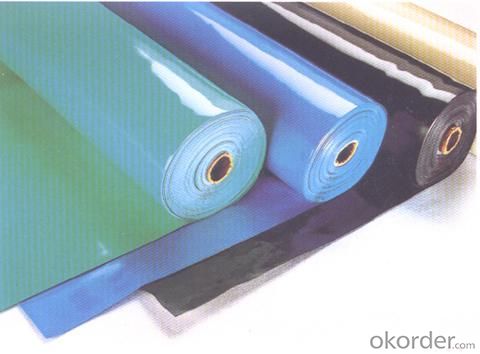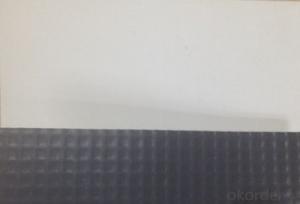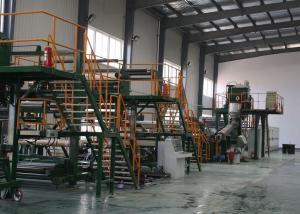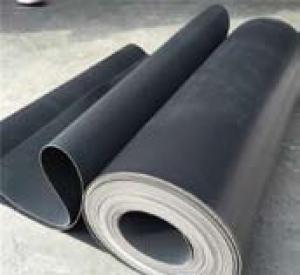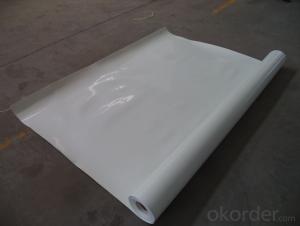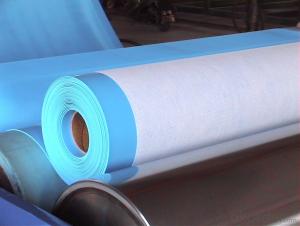TPO Waterproof Membranes
- Loading Port:
- China Main Port
- Payment Terms:
- TT OR LC
- Min Order Qty:
- -
- Supply Capability:
- -
OKorder Service Pledge
OKorder Financial Service
You Might Also Like
PVC Waterproof Membrane
TPO Waterproof Membrane
Products Description
The Thermoplastice Polyolefin (TPO) waterproof membranes are the most
popular waterproof materials in the world at present. It’s thermoplastic elastomeric
waterproof materials by adopting advanced polymerization together with squeeze
technology,which perform well in mechanical properties, high tensile strength,
oxidation-resistance and resistance to puncture.
Products Specification
Divided by product categories:
1.non-homogeneous composite membrane (code H)
2.with fiber composite backing sheet (code L)
3.fabric reinforced sheet (code P)

Products Hall
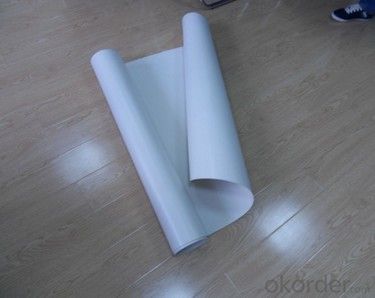
Physical Properties
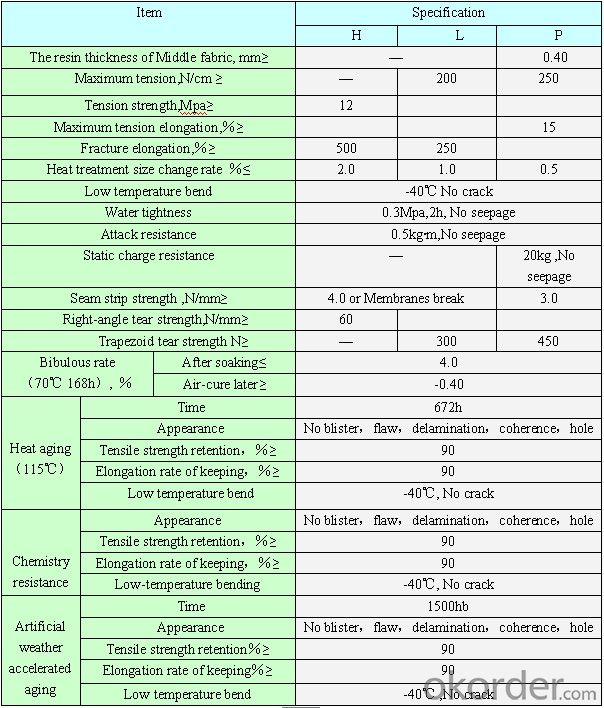
Application Range
Widely applied on various kinds of waterproofing projects:
1. Subways and tunnels
2. Roofs of sports complex
3. Green roofs
4. Exposed roofs
5. Steel roofs
6. Waste land filling yards
Wildly be used in roofing waterproof
- Q: Can a waterproofing membrane be used for temporary structures or tents?
- Yes, a waterproofing membrane can be used for temporary structures or tents. It provides an effective barrier against water infiltration, helping to keep the interior dry and protected from outside elements. This can be especially useful in temporary structures or tents where water resistance is crucial for comfort and safety.
- Q: Can a waterproofing membrane be used for tunnels or subway systems?
- Tunnels and subway systems frequently encounter water infiltration as a result of the soil conditions or groundwater levels in their vicinity. To counteract this issue, a waterproofing membrane is commonly employed. This membrane serves as a protective shield, effectively obstructing water from permeating into the tunnels or subway systems. Its installation is typically carried out on the outer surfaces of the tunnel walls and roof, establishing an impervious seal. By doing so, it aids in the prevention of corrosion, decay, and harm to the structural components of the tunnels, guaranteeing the durability and safety of these subterranean infrastructures.
- Q: Can a waterproofing membrane be used in conjunction with vapor barriers?
- Yes, a waterproofing membrane can be used in conjunction with vapor barriers. While a waterproofing membrane protects against liquid water infiltration, a vapor barrier is designed to prevent the passage of moisture vapor. By combining both, you can effectively protect a structure from both liquid water and moisture vapor, ensuring a comprehensive moisture management system.
- Q: Does a waterproofing membrane require any specialized tools or equipment for installation?
- Yes, the installation of a waterproofing membrane typically requires specialized tools and equipment. Some of the common tools and equipment used for installation include a trowel or roller for spreading the membrane, a utility knife for cutting and shaping the membrane, a heat gun or propane torch for activating and adhering the membrane, a seam roller for ensuring proper bonding of seams, and a caulking gun for applying sealant around penetrations and edges. Additionally, depending on the specific type of waterproofing membrane being installed, other tools such as a primer, bonding adhesive, or specialized membrane fasteners may be required. It is important to consult the manufacturer's installation guidelines to ensure the proper tools and equipment are used for a successful installation.
- Q: Can waterproofing membranes be used on utility vaults?
- Yes, waterproofing membranes can be used on utility vaults. Utility vaults are typically underground structures that house important utility equipment such as electrical transformers, water meters, or communication systems. These vaults are susceptible to water infiltration, which can cause damage to the equipment and compromise its functionality. Waterproofing membranes are a common solution to prevent water from entering utility vaults. These membranes are typically made of durable materials such as rubber, PVC, or modified bitumen, which provide an impermeable barrier against water. They are applied to the walls and floors of the vault, creating a watertight seal that prevents moisture from seeping in. By using waterproofing membranes on utility vaults, the risk of water damage is significantly reduced. This helps to ensure the functionality and longevity of the equipment housed inside. Additionally, waterproofing membranes can also provide protection against other potential issues such as leaks, corrosion, and chemical damage. However, it is important to note that the application of waterproofing membranes on utility vaults requires proper surface preparation and installation techniques to ensure a successful and long-lasting waterproofing system. Therefore, it is recommended to consult with a professional waterproofing contractor who has experience in working with utility vaults to ensure the best results.
- Q: Can a waterproofing membrane be used for a residential building facade?
- A residential building facade can utilize a waterproofing membrane. This material is applied to the exterior surface of the building to prevent water from penetrating and damaging the structure due to moisture. It proves particularly beneficial for residential buildings that are exposed to different weather conditions. The utilization of a waterproofing membrane for a residential building facade offers several advantages. Firstly, it prevents water from seeping through the facade and causing harm to the interior walls, insulation, and other building materials. This ensures a dry and comfortable living environment inside the house. Moreover, a waterproofing membrane extends the lifespan of the building facade by acting as a protective barrier against moisture and water-related issues like mold, mildew growth, and efflorescence. This condition causes discoloration and deterioration of the facade over time due to mineral deposits from water. Furthermore, this type of membrane enhances the energy efficiency of a residential building. It achieves this by preventing water infiltration, thereby maintaining proper insulation and reducing air leakage. This, in turn, reduces the energy required for heating or cooling the building. However, it is crucial to select the appropriate waterproofing membrane for the specific requirements of the residential building facade. There are several options available, including liquid-applied membranes, sheet membranes, and spray-applied membranes. Each option has its own advantages and limitations. Therefore, consulting a professional waterproofing contractor or architect is advisable to determine the most suitable membrane system for the project. Additionally, proper installation and regular maintenance are essential to ensure the effectiveness and longevity of the waterproofing membrane on the residential building facade.
- Q: What is the lifespan of a waterproofing membrane in extreme weather conditions?
- The lifespan of a waterproofing membrane in extreme weather conditions can differ depending on various factors. These factors include the quality of the membrane, the intensity and duration of the weather conditions, and the maintenance and care given to the membrane. Typically, waterproofing membranes designed for extreme weather conditions can last 20-30 years or more if they are of high quality. These membranes are usually made from durable materials like modified bitumen, PVC, EPDM, or TPO. These materials are specifically engineered to endure harsh weather elements. It is worth noting that extreme weather conditions, such as heavy rain, intense sunlight, freezing temperatures, or strong winds, can speed up the deterioration of the membrane. For instance, prolonged exposure to UV radiation can cause the membrane to degrade and lose its effectiveness over time. To extend the lifespan of the waterproofing membrane in extreme weather conditions, regular maintenance and inspections are crucial. By promptly addressing any signs of damage, such as cracks, tears, or leaks, and conducting regular cleaning and resealing, the membrane can be better shielded against the harsh effects of extreme weather. Moreover, proper installation techniques and adherence to the manufacturer's guidelines are vital for ensuring the longevity of the waterproofing membrane. Hiring experienced professionals who are familiar with installing membranes in extreme weather conditions can significantly contribute to the durability and lifespan of the membrane. Ultimately, while a high-quality waterproofing membrane can endure extreme weather conditions for several decades, it is important to regularly monitor its condition, provide proper care and maintenance, and promptly address any issues that arise in order to maximize its lifespan.
- Q: Can a waterproofing membrane be used on plywood surfaces?
- Yes, a waterproofing membrane can be used on plywood surfaces. The membrane acts as a barrier to prevent water penetration, protecting the plywood from moisture damage and extending its lifespan.
- Q: Can a waterproofing membrane be used for underground utility tunnels?
- Underground utility tunnels can benefit greatly from the use of a waterproofing membrane. This membrane, a thin layer of material, is applied to the surface of structures to prevent water or moisture from entering. It is commonly used in construction to safeguard buildings and structures from water damage. In the case of underground utility tunnels, where the risk of water infiltration is high due to surrounding soil and groundwater, a waterproofing membrane is extremely advantageous. It acts as a reliable barrier, effectively blocking water from entering the tunnel and causing harm to the utilities inside. There are various types of waterproofing membranes available, such as sheet membranes, liquid membranes, and spray-applied membranes. These membranes are typically made from materials like asphalt, modified bitumen, polyurethane, or rubberized asphalt. They are designed to be durable, flexible, and resistant to water and other environmental factors. Proper surface preparation is essential before applying a waterproofing membrane to an underground utility tunnel. The surface should be thoroughly cleaned, free of debris, and in good condition. Following the manufacturer's instructions, the membrane should then be installed, ensuring that all seams and joints are adequately sealed to create an uninterrupted water-resistant barrier. It's important to note that waterproofing membranes alone are not sufficient for protecting underground utility tunnels. They should be used in conjunction with other waterproofing measures, such as proper drainage systems, to ensure comprehensive water protection. Regular inspection and maintenance of the membrane are also necessary to promptly address any damage or deterioration. In conclusion, a waterproofing membrane is an effective solution for safeguarding underground utility tunnels against water infiltration. By establishing a strong and durable barrier against moisture, it helps maintain the integrity of utilities and prolong the lifespan of tunnel infrastructure.
- Q: Can a waterproofing membrane be used for data centers?
- Yes, a waterproofing membrane can be used for data centers. Waterproofing membranes are commonly used in construction to prevent water intrusion and leakage. In data centers, where protection against water damage is crucial for sensitive equipment and infrastructure, a waterproofing membrane can provide an additional layer of protection to safeguard against potential water leaks or flooding.
Send your message to us
TPO Waterproof Membranes
- Loading Port:
- China Main Port
- Payment Terms:
- TT OR LC
- Min Order Qty:
- -
- Supply Capability:
- -
OKorder Service Pledge
OKorder Financial Service
Similar products
Hot products
Hot Searches
Related keywords



